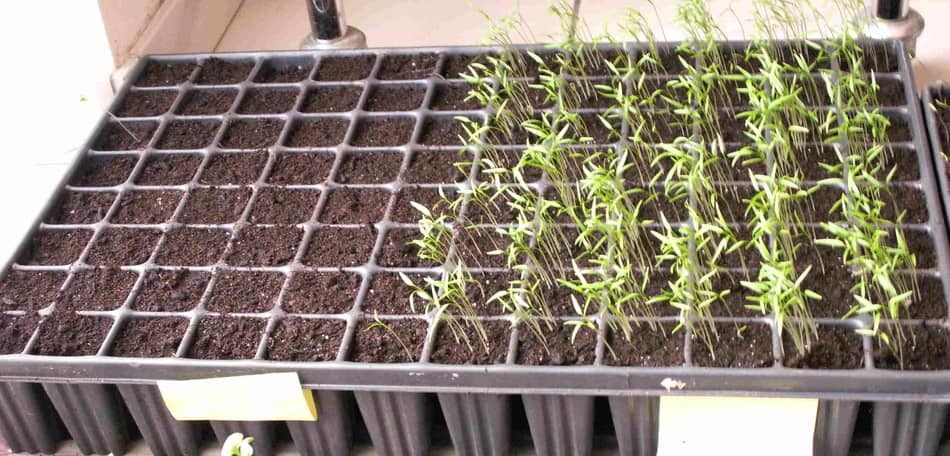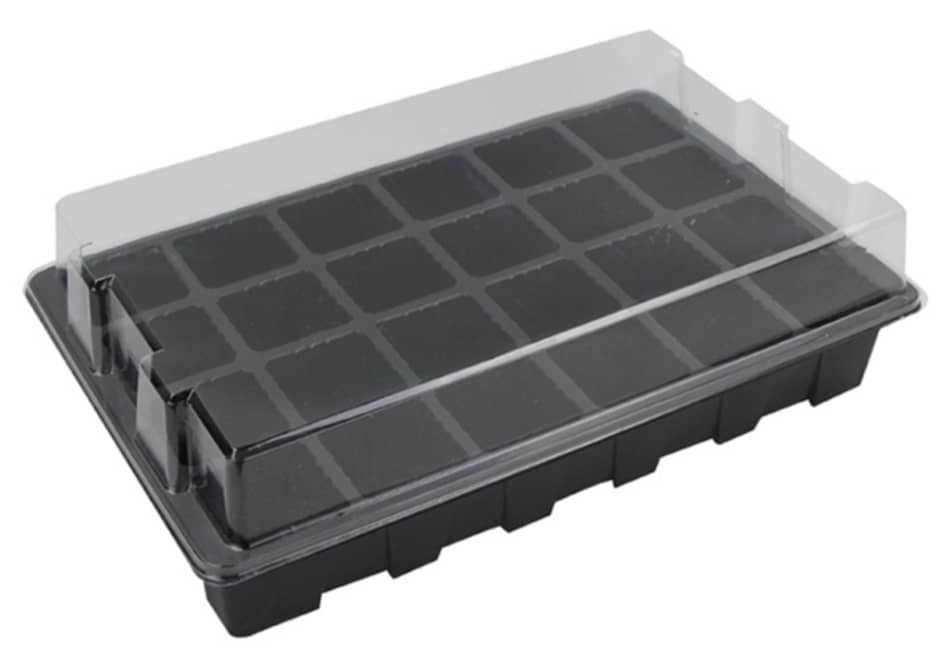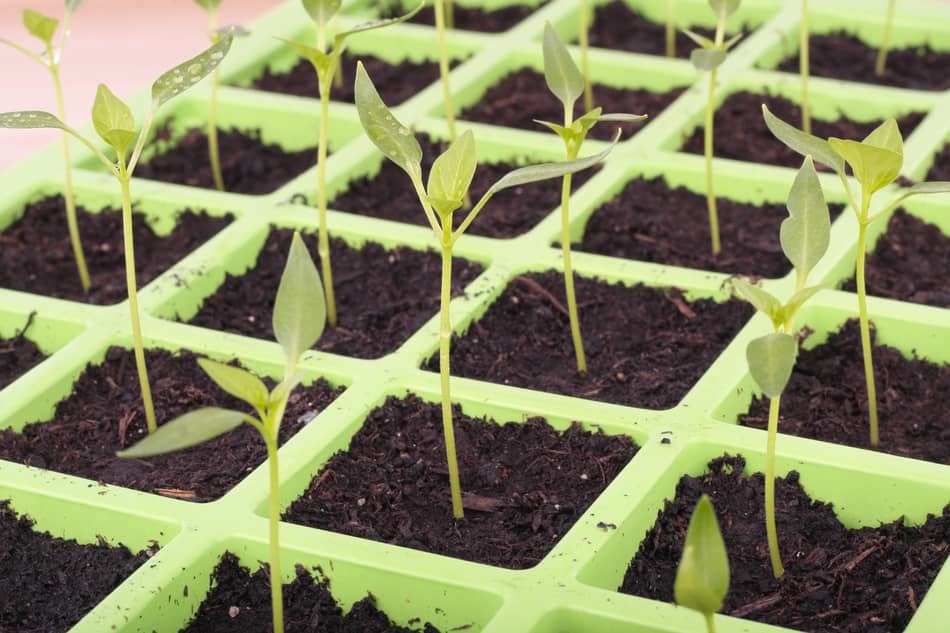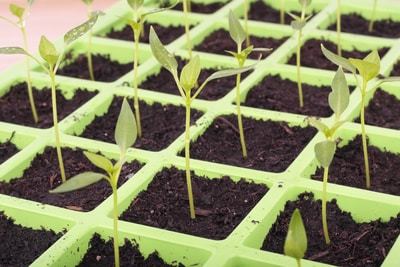OK, so maybe you don’t have a yard–but you still want to make a tiny greenhouse, maybe for your apartment. We’ve got you covered–you actually don’t need a big yard OR green thumb to start a greenhouse. With the right supplies and information, you can have your own greenhouse in the smallest of apartments.
To make an indoor greenhouse for your apartment, here’s–bare bones–what you’ll need: seeds, planting tray(s) and lid(s), and planting soil. If you want, you can get a little fancier by adding a timer, grow light, multiple shelves, and even an enclosure to contain everything.
If you don’t have an area that gets at least 8 hours full sun every day, you can read how sunlight vs. grow lights affect plant growth.

Keep in mind that the kinds of plants you grow will determine exactly what supplies you’ll need for your apartment greenhouse. For example, some plants might:
- Need more light (so, if you don’t have a sunny window or it’s winter, you might need a grow light)
- Need more humidity (especially if your apartment gets dry in the winter)
- Grow tall (like tomatoes, so you’ll need a taller enclosure than the typical 7” planting tray lid–also called a dome)
Where to start
Before you scramble around gathering supplies, you’ll need to decide what you want from your little apartment greenhouse.
Before you dive in though, you might want to read our definitive guide on indoor greenhouses.
Why do you want a greenhouse for your apartment? Do you:
- Want to add some life to your apartment?
- Want to grow herbs?
- Want to grow things you can eat–like greens, tomatoes, or strawberries?
- Want to grow medicinal plants–like aloe or mint?
- Want to grow your own food, like having homegrown vegetables during the dead of winter?
- Want to learn about how to grow plants?
Next, you’ll need to decide where you’ll put your greenhouse. Here’s a list of things to consider:
- Where in your apartment will you put your greenhouse?
- Do you have a window that brings in lots of light? (North-facing windows won’t get any direct sunlight).
- How tall will your plants grow? Taller plants, like bamboo or tomatoes, can take up more space. Also, some plants require deeper roots, which means you’ll need a deeper container so they can thrive.
- Do you have a cat or dog? Cats especially can be curious & mischievous, and can knock down or eat plants. If your cat is like that, you’ll need to protect or cover your plants.
Recommended plants
Below is a list of recommended plants, but you can read more comprehensive info on growing veggies year-round in a greenhouse.
You’ve already thought through why you want a little greenhouse in your apartment, figured out where you’ll put it & how much space you have. Now it’s time to decide what are the best plants for your apartment.
Depending on what you want & your experience, you might try starting with high-yield crops or easy-to-grow plants.
A few high-yielding edible plants that are suited to apartment growing include: microgreens and salad greens, though you can even grow tomatoes, peppers, and strawberries. Probably the easiest though are greens.
Common plants that work well in an apartment greenhouse:
- Salad greens
- Microgreens
- Mushrooms
- Herbs
- Radishes
- Ginger
- Tomatoes
- Peppers
- Strawberries
- Carrots
- Garlic: see our guide to growing garlic indoors
- Scallions / green onions
- Peas
- Green beans
- Lavender: see our guide to growing lavender indoors
You might decide to start with a handful of different types, then see how they do.
Surprisingly, edible plants like tomatoes, peppers, and strawberries can all thrive if they can get enough light. Natural sunlight is ideal, but you can also supplement with grow lights.

Setting things up
OK, you’ve decided a spot for your mini apartment greenhouse. And you’ve decided what you want to grow.
Here’s what else you’ll need–at a minimum:
- Soil:
- Most all plants need well-drained soil. Basically, you don’t want plants sitting in mushy soil or stagnant water, since that’ll rot the roots & kill your fledgling apartment garden.
- Fertilizer: Keep in mind that most brands of potting soil are made up mostly of peat moss and coconut coir (which is the ground-up outer husk of the coconut). So, if your plants only have those ingredients for their soil, they won’t have everything they need to thrive. At a certain point, your burgeoning plants might tap out & exhaust all the nutrients from their potting soil, and they’ll need additional nutrients to continue healthy growth. Supplementing with compost or organic fertilizer can help ensure your plants get all the nutrients they need to keep thriving & growing.
- Trays or pots:
- Depending on what types of plants you want to grow, you might be able to simply use shallow trays–especially if you’re only growing microgreens, which, given their shallow roots, don’t need a deep pot. On the other hand, some plants will need more substantial & deeper pots. Again, the table above will give you an idea for how large or deep a planting tray or pot you’ll need for the types of plants you want to grow.
Optional or helpful supplies:
- Grow lights: These are useful, especially if your apartment doesn’t get much light, or the plants you’re going to grow require lots of sunlight each day. For example, if you want to grow tomatoes in, say, January, and your apartment only has a small, north-facing window, your tomato plants might grow, but they’ll likely be spindly, won’t flower, and won’t produce any tomatoes. In that case, you’d want to supplement the lackluster light in your apartment with lights for indoor growing–not just any light, but you’ll need one that’ll give your plants the right kind of light and enough (but not too much) of it so they can do really well. If you decide you need a grow light, you’ll also want a timer so you can regulate how much light your plants get–not too much & not too little.
- Labels: Labels are great, especially to keep track of what you planted and when you planted it. For example, if you’re growing plants from seeds, it’s hard to wait for them to germinate, since some varieties can take a couple weeks or more to emerge from the soil. And by that time, it’s easy to forget what you planted. All you need is a simple label so you can write the plant name & date you planted it–that way, you’ll know when to expect it to germinate, and how to recognize it when it finally emerges from the soil.
- Thermometer: Not essential, but certainly handy. For example, you don’t want your plants getting too cold or too warm, since either extreme can be harmful–especially depending on what type of plants you’re growing. A basic thermometer can do the job, but even better are thermometers that tell you the daily maximum & minimum temperatures; that way, you don’t have to constantly check the temperature. Also, the maximum & minimum temperatures are typically what cause problems for plants–either getting too hot or too cold.
- Soil moisture probe: Optional, but handy, especially if you’re growing finicky plants. Most times you can just use your finger to gauge the soil moisture by wiggling your finger down into the soil an inch or so, then seeing if your finger is dry (water needed), muddy (too much water), or has little bits of soil on it (ideal).
- Humidity measurement: Again, this is optional, but can be useful in some situations. For example, in winter when indoors is typically very dry, and you’re growing plants that need high humidity.
- Lid, dome, or enclosure: Depending on your plants–or whether you’ve got a cat who’s a troublemaker–you might want to keep your plants covered in their own personal greenhouse. If you just planted seeds, then a shallow lid is sufficient. Once the seeds germinate & emerge from the soil, you might need a taller lid–usually called a dome–or you might even decide to enclose everything as a mini greenhouse.
Maintenance
Now that you’ve planted your mini greenhouse, what’s next?
Well, you want to make sure your fledging plants do well. The main things to manage are:
- Light: Depending on the time of year, the same apartment window might let in more or less light. So you’ll want to monitor how much light your plants get–especially if they need more light to grow, produce flowers, and set fruit–like tomatoes & peppers.
- Temperature: Some plant varieties are more tolerant of cold & heat, and other varieties require warm temperatures. A thermometer–especially one that shows the daily maximum & minimum–will let you know if your plants are warm enough & not too chilly.
- Humidity: If your greenhouse has a lid or dome, or is fully enclosed, you can see if there’s fogging on surface of lid/dome, or you can use a probe if you’re extra geeky. Either way, you want to make sure your greenhouse is just right for what you’re growing in it–not too dry & not to moist.
- Water: This is usually pretty straightforward. The soil should be slightly moist but not soggy.
- Other nutrients: Like I mentioned above, you may need to add compost or organic fertilizer through the year, especially if the potting soil you used for planting is deficient in nutrients, or if your plants require more–like tomatoes or peppers.

Related questions
Do you need a grow light in a greenhouse? If your plants require high light or they’re growing in winter–or in a low-light area–you’ll probably need grow lights. If your plants are spindly or top-heavy, they’re investing their energy to reach toward the light instead of putting their energy into leaves, flowers, and fruit.
What fruits and vegetables can grow indoors? You can grow a surprising variety of fruits & vegetables indoors: carrots, avocados, lemons, mini oranges, microgreens, mushrooms, salad greens, tomatoes, peppers, radishes, green beans, peas, scallions, herbs, and even some edible roots like ginger, turmeric, and sweet potatoes.
How to build an indoor greenhouse? An indoor greenhouse is similar to an apartment greenhouse–but typically bigger. The easiest way is to construct your greenhouse using narrow PVC pipe or wood, then cover it with plastic. However, kits are widely available for indoor greenhouses.

